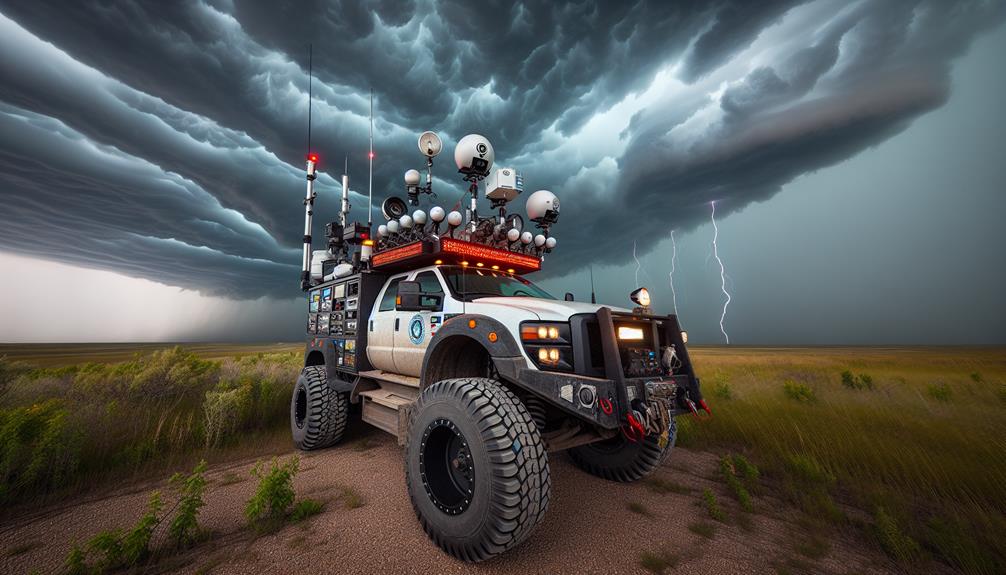To stay safe while intercepting severe thunderstorms, we must analyze weather patterns using advanced forecasting models and monitor real-time radar and satellite data. We should wear protective gear, like high-visibility, waterproof jackets and slip-resistant boots. Key safety equipment includes anemometers and lightning detectors. Effective communication involves using multiple weather alert sources and maintaining coordination. Our emergency protocols need clear, actionable steps and identified shelters. Finally, vehicle preparation is vital; reinforced tires, heavy-duty wipers, and auxiliary power sources guarantee safety. Discover more about each of these strategies to further enhance your safety.
Key Points
- Wear high-visibility, waterproof gear and sturdy boots for protection.
- Utilize real-time radar and satellite data to monitor storm movements.
- Equip vehicles with reinforced tires and heavy-duty wipers for better control and visibility.
- Maintain multiple communication devices and emergency contact lists for coordination.
Understanding Weather Patterns
To effectively intercept severe thunderstorms, we must analyze and interpret the intricate weather patterns that signal their formation. Utilizing advanced weather forecasting models, we can identify key atmospheric indicators such as temperature gradients, humidity levels, and wind shear. These factors provide essential data that allow us to predict the likelihood of thunderstorm development with precision.
Storm tracking requires a detailed understanding of real-time radar imagery and satellite data. By monitoring the movement of cold fronts, low-pressure systems, and jet streams, we can pinpoint potential storm genesis zones. Additionally, Doppler radar technology enables us to observe precipitation intensity and storm cell rotation, which are crucial for predicting severe weather events like tornadoes and hailstorms.
We must also consider mesoscale convective systems (MCS) and their role in storm evolution. By analyzing convective available potential energy (CAPE) and convective inhibition (CIN), we can assess the atmosphere's readiness for thunderstorm initiation. This data-driven approach empowers us to make informed decisions about when and where to intercept storms, maximizing our ability to operate safely while pursuing our passion for storm chasing.
Essential Safety Gear
Equipping ourselves with essential safety gear is vital for mitigating risks while intercepting severe thunderstorms. Our first line of defense is protective clothing. High-visibility, waterproof jackets and pants are essential to remain both seen and dry in torrential rain. We should opt for materials rated for high wind resistance, such as Gore-Tex, to withstand gusts associated with severe weather events. Additionally, sturdy, waterproof boots with slip-resistant soles guarantee traction on slick surfaces.
Safety equipment also plays a crucial role. A reliable anemometer helps us measure wind speeds accurately, providing essential data to make informed decisions. Portable lightning detectors alert us to nearby strikes, giving us a head start to seek shelter. Wearing a hard hat protects against debris propelled by strong winds, while safety goggles shield our eyes from flying particles.
We can't overlook the importance of a first-aid kit, fully stocked with essentials like bandages, antiseptics, and burn ointments. A multi-tool equipped with a knife, pliers, and screwdriver can be invaluable for emergency repairs.
Lastly, handheld GPS units guarantee we navigate safely without relying solely on cellular networks, which can be unreliable in storm conditions. By meticulously selecting our protective clothing and safety equipment, we enhance our safety and operational efficiency.
Communication Strategies
Our preparedness isn't complete without strong communication strategies to guarantee real-time coordination and safety during severe thunderstorms. Effective communication methods, coupled with reliable emergency contacts, form the backbone of our storm interception efforts.
We need to make sure that everyone on our team is on the same page, especially when the weather conditions are rapidly changing.
To optimize our communication strategies, consider the following:
- Weather Alerts: Utilize multiple sources for weather alerts. Integrate National Weather Service updates, radar apps, and specialized meteorological feeds to get timely and accurate information. This redundancy ensures we're never caught by surprise.
- Communication Devices: Equip our team with various communication devices. Two-way radios, satellite phones, and mobile apps designed for storm chasers can maintain connectivity even in remote areas where cell service is unreliable.
- Emergency Contacts: Maintain an up-to-date list of emergency contacts. This should include local emergency services, nearby hospitals, and other storm chasers in the vicinity. Quick access to these contacts can be essential in case of unexpected incidents.
Emergency Protocols
Setting clear and actionable emergency protocols is crucial to guaranteeing our safety while intercepting severe thunderstorms. We need to identify robust shelter options well in advance. This involves locating structurally sound buildings, preferably reinforced structures, and making sure they're accessible from our current positions.
Equally important is maintaining a list of emergency contacts. This should include local emergency services, meteorological stations, and team members' contact information to coordinate efficiently.
Establishing evacuation routes is another crucial aspect. We must map multiple, easily navigable paths from our intercept points to predetermined safe zones. These routes should avoid flood-prone areas and be regularly updated based on real-time data. Having an accurate GPS system and offline maps can greatly enhance our situational awareness.
Emergency supplies are non-negotiable. Each team member's kit should contain first-aid essentials, non-perishable food, water, flashlights, multi-tools, and weather radios. These supplies ensure we're prepared for a range of scenarios, from being stranded to providing immediate medical assistance.
Vehicle Preparation Tips

Preparing our vehicles for intercepting severe thunderstorms requires a detailed inspection of mechanical systems, guaranteeing peak performance and reliability under extreme conditions. We can't afford mechanical failures when we're out in the field, so our preparation must be thorough and intentional.
First, we need to focus on an in-depth vehicle inspection covering critical aspects like brakes, tires, battery, and fluid levels. Identifying and addressing any potential issues beforehand minimizes risks and enhances our safety.
Second, stocking our vehicles with essential emergency supplies is vital. This includes first-aid kits, flashlights, and non-perishable food. A weather app on our devices will provide real-time updates, helping us stay ahead of storm developments.
Third, we must adhere to strict safety precautions by equipping our vehicles with necessary equipment such as:
- Heavy-duty wipers – Ensuring visibility during heavy rainfall.
- Reinforced tires – Provides better traction and stability on wet or uneven surfaces.
- Auxiliary power sources – Keeps communication devices operational if the vehicle's battery fails.
Frequently Asked Questions
How Can I Identify the Early Signs of a Severe Thunderstorm?
To identify early signs of a severe thunderstorm, we should monitor cloud formations and wind patterns, watch for frequent lightning strikes, and note any sudden temperature drops. These indicators help us anticipate severe weather conditions effectively and efficiently.
What Apps or Tools Are Best for Real-Time Weather Updates?
For real-time weather updates, we recommend weather radar apps like RadarScope and storm tracking tools such as Storm Shield. Utilizing weather satellites and emergency alerts guarantees precise data, granting us the freedom to make informed decisions.
How Should I Handle Encounters With Hail During a Thunderstorm?
When hail looms, our first move is to activate vehicle protection using hail guards. This mitigates hail damage and reduces potential insurance claims. Always prioritize finding shelter before the storm intensifies to secure maximum safety and freedom.
Can Pets Be Safely Brought Along During Storm Chasing?
Regarding pets' safety, we shouldn't bring them storm chasing. Develop an emergency plan prioritizing their well-being at home. Data indicates pets face high risk of injury or distress in severe weather scenarios. Prioritize their safety.
What Should I Do if My Vehicle Is Struck by Lightning?
If lightning strikes our vehicle, it's like a million volts of danger! For lightning safety and vehicle protection, stay inside, avoid touching metal, and wait for the storm to pass. Remember, our car acts as a Faraday cage.


